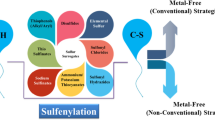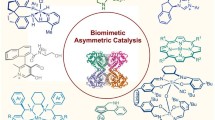Abstract
Several amides of 3-(3′,6′-dioxo-2′,4′-dimethylcyclohexa-l′,4′-diene)-3,3-diniethylpropionic acid (2) have been synthesized and tested as model redox-sensitive pro-prodrugs of amines. The reduction of these model pro-prodrugs generated hydroxy amide intermediates 4a-4h, the lactonization of which resulted in amine release. The rates of lactonization of 4a-4h were investigated at pH 7.4 and 37°C. The half-lives for appearance of the product lactone la from these intermediates were found to range from 1.4 to 3.4 min. With such rapid lactonization rates, it is believed that reduction will be the rate-limiting step in the two-step conversion of the pro-prodrug to the amine.
Similar content being viewed by others
REFERENCES
V. Stella. Prodrugs: An overview and definition. In T. Higuchi and V. Stella (eds.), Pro-drugs as Novel Drug Delivery Systems, American Chemical Society, Washington, DC, 1975, pp. 1–115.
A. A. Sinkula and S. H. Yalkowsky. Rationale for design of biologically reversible drug derivatives: prodrugs. J. Pharm. Sci. 64:181–210 (1975).
I. H. Pitman. Pro-drugs of amides, imides and amines. Med. Res. Rev. 1:187–212 (1981).
H. Bundgaard. Design of Prodrugs, Elsevier, Amsterdam, 1985, pp. 1–92.
B. F. Cain. 2-Acyloxymethylbenzoic acids. Novel amine protective functions providing amides with the lability of esters. J. Org. Chem. 41:2029–2031 (1976).
N. M. Nielsen and H. Bundgaard. Prodrugs as drug delivery systems. 42. 2-Hydroxymethylbenzamides and 2-acyloxymethylbenzamides as potential prodrug forms for amines. Int. J. Pharm. 29:9–18 (1986).
C. D. Johnson, S. Lane, P. N. Edwards, and P. J. Taylor. Prodrugs based on masked lactones. Cyclization of γ-hydroxy amides. J. Org. Chem. 53:5130–5139 (1988).
K. L. Amsberry and R. T. Borchardt. Lactonization of o-hydroxyhydrocinnamic acid amides and their potential as drug carriers. Pharm. Res. 5:s-61 (1988).
K. L. Amsberry and R. T. Borchardt. The lactonization of 2′-hydroxyhydrocinnamic acid amides: A potential prodrug for amines. J. Org. Chem. 55:5867–5877 (1990).
H. Bundgaard. The double prodrug concept and its applications. Adv. Drug Del. Rev. 3:39–65 (1989).
K. L. Amsberry, A. E. Gerstenberger, and R. T. Borchardt. Amine prodrugs which utilize hydroxy amide lactonization. II. A potential esterase-sensitive amide prodrug. Pharm. Res. 8:455–461 (1991).
D. E. Duggan. Sulindac: Therapeutic implications of the prodrug/pharmacophore equilibrium. Drug Metab. Rev. 12:325–337 (1981).
N. Bodor, E. Shek, and T. Higuchi. Improved delivery through biological membranes. 1. Synthesis and properties of 1-methyl-l,6-dihydropyridine-2-carbaldoxime chloride. J. Med. Chem. 19:102–107 (1976).
E. Shek, T. Higuchi, and N. Bodor. Improved delivery through biological membranes. 2. Distribution, excretion and metabolism of N-methyl-l,6-dihydropyridine-2-carbaldoxime hydrochloride, a pro-drug of N-methylpyridinium-2-carbaldoxime chloride. J. Med. Chem. 19:108–112 (1976).
E. Shek, T. Higuchi, and N. Bodor. Improved delivery through biological membranes. 2. Delivery of N-methylpyridinium-2-carbaldoxime chloride through the blood-brain barrier in its dihydropyridine pro-drug form. J. Med. Chem. 19:108–112 (1976).
N. Bodor and A. M. AbdelAlim. Improved delivery through biological membranes XIX: Novel redox carriers for brain-specific chemical delivery systems. J. Pharm. Sci. 74:241–245 (1985).
L. H. Gray. Radiobiological basis of oxygen as a modifying factor in radiation therapy. Am. J. Roentg. 85:803–815 (1961).
H. B. Hewitt and C. W. Wilson. Effect of tissue oxygen tension on radiosensitivity of leukaemia cells irradiated in situ in livers of leukaemic mice. Br. J. Cancer 13:675–684 (1959).
I. F. Tannock. The relation between cell proliferation and the vascular system in a transplanted mouse mammary tumour. Br. J. Cancer 22:258–273 (1968).
W. A. Denny and W. R. Wilson. Considerations for the design of nitrophenyl mustards as agents with selective toxicity for hypoxic tumor cells. J. Med. Chem. 29:779–887 (1986).
K. A. Kennedy, B. A. Teicher, S. Rockwell, and A. C. Sartorelli. The hypoxic tumor cell: A target for selective cancer chemotherapy. Biochem. Pharmacol. 29:1–8 (1980).
R. T. Borchardt and L. A. Cohen. Stereopopulation control. III. Facilitation of intramolecular conjugate addition of the carboxyl group. J. Am. Chem. Soc. 94:9175–9182 (1972).
L. A. Carpino, S. A. Trioli, and R. A. Berglund. Reductive lactonization of strategically methylated quinone propionic acid esters and amides. J. Org. Chem. 54:3303–3310 (1989).
V. N. Iyer and W. Szybalski. Mitomycins and porfiromycin: Chemical mechanism of activation and cross-linking of DNA. Science 145:55–58 (1964).
H. S. Schwartz, J. E. Sodergren, and F. S. Philips. Mitomycin C: Chemical and biological studies on alkylation. Science 142:1181–1183 (1963).
H. S. Schwartz. Pharmacology of mitomycin C. III. In vitro metabolism by rat liver. J. Pharmacol. Exp. Ther. 136:250–258 (1962).
A. J. Lin, B. J. Lillis, and A. C. Sartorelli. Potential bioreductive alkylating agents. 5. Antineoplastic activity of quinoline-5,8-diones, naphthazrins and naphthoquinones. J. Med. Chem. 18:917–921 (1975).
A. J. Lin and A. C. Sartorelli. Potential bioreductive alkylating agents. VI. Determination of the relationship between oxidation-reduction potential and antineoplastic activity. Biochem. Pharmacol. 25:206–207 (1976).
Author information
Authors and Affiliations
Rights and permissions
About this article
Cite this article
Amsberry, K.L., Borchardt, R.T. Amine Prodrugs Which Utilize Hydroxy Amide Lactonization. I. A Potential Redox-Sensitive Amide Prodrug. Pharm Res 8, 323–330 (1991). https://doi.org/10.1023/A:1015885213625
Issue Date:
DOI: https://doi.org/10.1023/A:1015885213625




